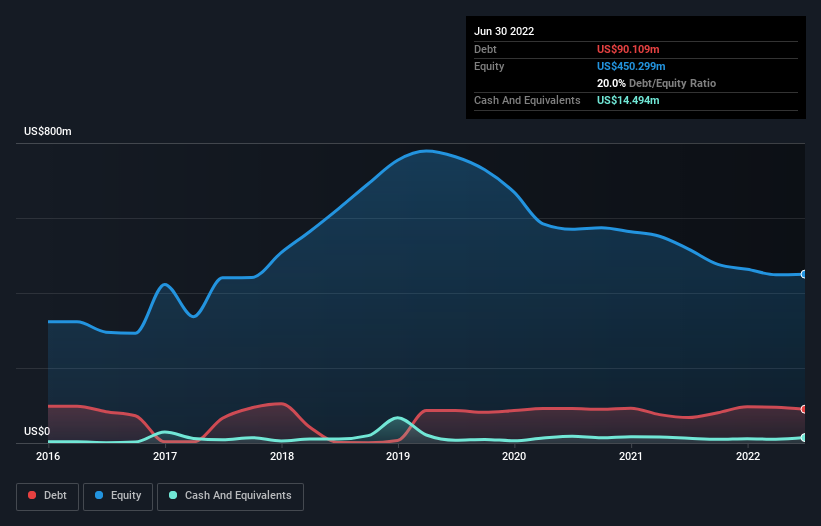- United States
- /
- Energy Services
- /
- NasdaqGS:TUSK
Here's Why Mammoth Energy Services (NASDAQ:TUSK) Can Afford Some Debt

Some say volatility, rather than debt, is the best way to think about risk as an investor, but Warren Buffett famously said that 'Volatility is far from synonymous with risk.' It's only natural to consider a company's balance sheet when you examine how risky it is, since debt is often involved when a business collapses. We note that Mammoth Energy Services, Inc. (NASDAQ:TUSK) does have debt on its balance sheet. But is this debt a concern to shareholders?
When Is Debt Dangerous?
Debt and other liabilities become risky for a business when it cannot easily fulfill those obligations, either with free cash flow or by raising capital at an attractive price. In the worst case scenario, a company can go bankrupt if it cannot pay its creditors. While that is not too common, we often do see indebted companies permanently diluting shareholders because lenders force them to raise capital at a distressed price. Of course, debt can be an important tool in businesses, particularly capital heavy businesses. The first thing to do when considering how much debt a business uses is to look at its cash and debt together.
See our latest analysis for Mammoth Energy Services
What Is Mammoth Energy Services's Net Debt?
The image below, which you can click on for greater detail, shows that at June 2022 Mammoth Energy Services had debt of US$90.1m, up from US$68.0m in one year. However, because it has a cash reserve of US$14.5m, its net debt is less, at about US$75.6m.

A Look At Mammoth Energy Services' Liabilities
The latest balance sheet data shows that Mammoth Energy Services had liabilities of US$144.9m due within a year, and liabilities of US$107.9m falling due after that. Offsetting these obligations, it had cash of US$14.5m as well as receivables valued at US$430.6m due within 12 months. So it actually has US$192.3m more liquid assets than total liabilities.
This excess liquidity is a great indication that Mammoth Energy Services' balance sheet is almost as strong as Fort Knox. On this view, lenders should feel as safe as the beloved of a black-belt karate master. There's no doubt that we learn most about debt from the balance sheet. But you can't view debt in total isolation; since Mammoth Energy Services will need earnings to service that debt. So when considering debt, it's definitely worth looking at the earnings trend. Click here for an interactive snapshot.
In the last year Mammoth Energy Services's revenue was pretty flat, and it made a negative EBIT. While that's not too bad, we'd prefer see growth.
Caveat Emptor
Importantly, Mammoth Energy Services had an earnings before interest and tax (EBIT) loss over the last year. Indeed, it lost a very considerable US$95m at the EBIT level. That said, we're impressed with the strong balance sheet liquidity. That will give the company some time and space to grow and develop its business as need be. While the stock is probably a bit risky, there may be an opportunity if the business itself improves, allowing the company to stage a recovery. The balance sheet is clearly the area to focus on when you are analysing debt. But ultimately, every company can contain risks that exist outside of the balance sheet. Be aware that Mammoth Energy Services is showing 3 warning signs in our investment analysis , and 2 of those don't sit too well with us...
If, after all that, you're more interested in a fast growing company with a rock-solid balance sheet, then check out our list of net cash growth stocks without delay.
New: Manage All Your Stock Portfolios in One Place
We've created the ultimate portfolio companion for stock investors, and it's free.
• Connect an unlimited number of Portfolios and see your total in one currency
• Be alerted to new Warning Signs or Risks via email or mobile
• Track the Fair Value of your stocks
Have feedback on this article? Concerned about the content? Get in touch with us directly. Alternatively, email editorial-team (at) simplywallst.com.
This article by Simply Wall St is general in nature. We provide commentary based on historical data and analyst forecasts only using an unbiased methodology and our articles are not intended to be financial advice. It does not constitute a recommendation to buy or sell any stock, and does not take account of your objectives, or your financial situation. We aim to bring you long-term focused analysis driven by fundamental data. Note that our analysis may not factor in the latest price-sensitive company announcements or qualitative material. Simply Wall St has no position in any stocks mentioned.
About NasdaqGS:TUSK
Mammoth Energy Services
Operates as an energy services company in the United States, Canada, and internationally.
Flawless balance sheet and fair value.
Similar Companies
Market Insights
Community Narratives



